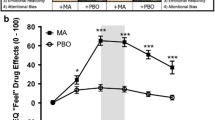Abstract
Rationale
We recently conducted a pilot study supporting the feasibility, safety, and validity of a human laboratory model of ad libitum cocaine administration in which subjects self-selected the timing of infusions. The current study extends this work to include a randomized design with a test–retest component in a larger sample.
Objectives
To investigate the regulation of cocaine intake by humans and its effects on subjective and cardiovascular responses.
Materials and methods
Subjects were 14 non-treatment seeking volunteers (10 M, 4 F) with cocaine abuse/dependence. Subjects self-administered cocaine infusions (0, 8, 16, and 32 mg/70 kg) over a 2-h period under a fixed ratio 1, 5-min time-out schedule on 4 consecutive days. A fifth session was conducted at 16-mg dose to assess the paradigm’s test–retest reliability.
Results
Subjects regulated their cocaine intake in a dose-dependent fashion. Self-reports of cocaine-related subjective effects (e.g., “high” and “stimulated”) also varied in a dose-dependent way. Test–retest data and the randomized design support the conclusion that such effects are not due to tolerance or other experimental artifacts.
Conclusion
The current study replicates prior work demonstrating the feasibility, safety, and validity of our human laboratory paradigm of cocaine administration in a larger sample using a randomized design. The current study also shows the test–retest reliability of these methods, establishing its utility for comparisons of experimental interventions (e.g., pharmacological treatments). Finally, the current study suggests that factors other than drug-induced euphoria (i.e., “high”) contribute to the regulation of cocaine-taking behaviors in humans.




Similar content being viewed by others
References
American Psychiatric Association (1994) Diagnostic and statistical manual of mental disorders, 4th edn. American Psychiatric, Washington, District of Columbia
Brunner E, Domhof S, Langer F (2002) Nonparametric analysis of longitudinal data in factorial experiments. Wiley, New York, NY
Donny EC, Bigelow GE, Walsh SL (2003) Choosing to take cocaine in the human laboratory: effects of cocaine dose, inter-choice interval, and magnitude of alternative reinforcement. Drug Alcohol Depend 69(3):289–301
Fischman MW (1989) Relationship between self-reported drug effects and their reinforcing effects: studies with stimulate drugs. In: Testing for abuse liability of drugs in humans. NIDA Research Monograph, Number 92
Fischman MW, Foltin RW (1992) Self-administration of cocaine by humans: a laboratory perspective. Ciba Found Symp 166:165–180
Fischman MW, Schuster CR (1982) Cocaine self-administration in humans. Fed Proc 41(2):241–246
Foltin RW, Fischman MW (1991) Smoked and intravenous cocaine in humans: acute tolerance, cardiovascular and subjective effects. J Pharmacol Exp Ther 257(1):247–261
Foltin RW, Haney M (2004) Intranasal cocaine in humans: acute tolerance, cardiovascular and subjective effects. Pharmacol Biochem Behav 78(1):93–101
Foltin RW, Fischman MW, Nestadt G, Stromberger H, Cornell EE, Pearlson GD (1990) Demonstration of naturalistic methods for cocaine smoking by human volunteers. Drug Alcohol Depend 26(2):145–154
Foltin RW, Fischman MW, Levin FR (1995) Cardiovascular effects of cocaine in humans: laboratory studies. Drug Alcohol Depend 37(3):193–210
Foltin RW, Ward AS, Haney M, Hart CL, Collins ED (2003) The effects of escalating doses of smoked cocaine in humans. Drug Alcohol Depend 70(2):149–157
Gawin FH, Kleber HD (1985) Cocaine use in a treatment population: patterns and diagnostic distinctions. NIDA Res Monogr 61:182–192
Lynch W, Carroll M (2001) Regulation of drug intake. Exp Clin Psychopharmacol 9:131–143
Lynch W, LaBounty L, Carroll M (1998) A novel paradigm to investigate regulation of drug intake in rats self-administering cocaine or heroin intravenously. Exp Clin Psychopharmacol 6:22–31
National Advisory Council on Drug Abuse (1997). Recommended guidelines for the administration of drugs to human subjects. Office for the Protection from Research Risks
Paly D, Jatlow P, Van Dyke C, Jeri FR, Byck R (1982) Plasma cocaine concentrations during cocaine paste smoking. Life Sci 30(9):731–738
Pickens R, Thompson T (1968) Cocaine-reinforced behavior in rats: effects of reinforcement magnitude and fixed-ratio size. J Pharmacol Exp Ther 161(1):122–129
Robinson TE, Berridge KC (2001) Incentive-sensitization and addiction. Addiction 96(1):103–114
Sughondhabirom A, Jain D, Gueorguieva R, Coric V, Berman R, Lynch WJ, Self D, Jatlow P, Malison RT (2005) A paradigm to investigate the self-regulation of cocaine administration in humans. Psychopharmacology 180(3):436–446
Tsibulsky VL, Norman AB (1999) Satiety threshold: a quantitative model of maintained cocaine self-administration. Brain Res 839(1):85–93
Ward AS, Haney M, Fischman MW, Foltin RW (1997) Binge cocaine self-administration in humans: intravenous cocaine. Psychopharmacology 132(4):375–381
Yokel RA, Pickens R (1973) Self-administration of optical isomers of amphetamine and methylamphetamine by rats. J Pharmacol Exp Ther 187(1):27–33
Acknowledgements
We gratefully acknowledge the excellent technical assistance of Marcia Mulligan and Megan Myers. We are grateful for the support of the National Institute on Drug Abuse (DA018978, WJL; DA DA00397, DA15857, DA12283, RTM), the Yale Interdisciplinary Women’s Health Research (IWHR) Scholar Program on Women and Drug Abuse (Carolyn Mazure, P.I.), the Yale General Medical Clinical Research Center (funded by NIH/NCRR/GCRC Program Grant M01-RR00125), the National Center for Research Resources (K12RR17594, PM) and the Department of Mental Health and Addiction Services (DMHAS) of the State of Connecticut.
Author information
Authors and Affiliations
Corresponding author
Rights and permissions
About this article
Cite this article
Lynch, W.J., Sughondhabirom, A., Pittman, B. et al. A paradigm to investigate the regulation of cocaine self-administration in human cocaine users: a randomized trial. Psychopharmacology 185, 306–314 (2006). https://doi.org/10.1007/s00213-006-0323-5
Received:
Accepted:
Published:
Issue Date:
DOI: https://doi.org/10.1007/s00213-006-0323-5




